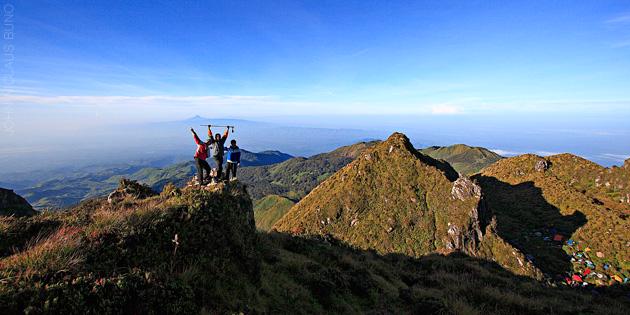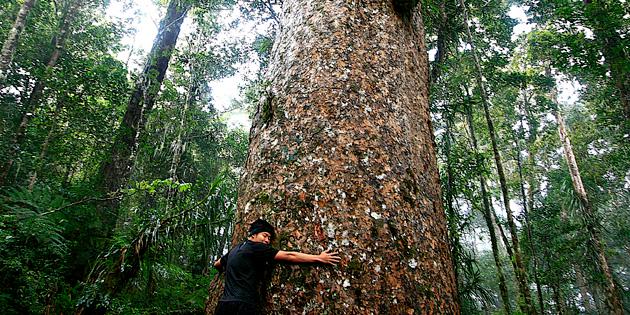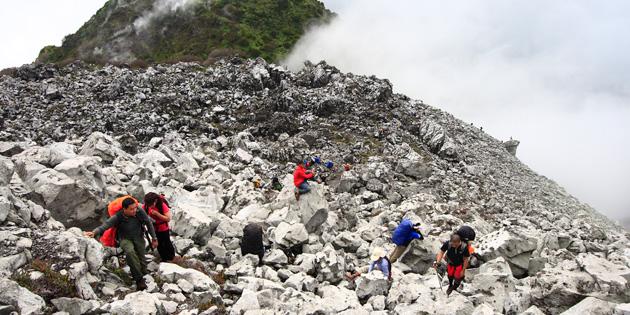
Mount Apo is a large solfataric, potentially-active stratovolcano in the island of Mindanao, Philippines.
With an altitude of 2,954 m (9,692 ft), Mt. Apo is the highest mountain in the country and is located between Davao City, Davao del Sur province and Cotabato province.
The peak overlooks Davao City 40 km (25 mi) to the northeast, Digos City 25 km (16 mi) to the southeast, and Kidapawan City 20 km (12 mi) to the west.
On May 9, 1936, Mount Apo was declared a national park by President Manuel L. Quezon.
The first two attempts to reach Mt. Apo’s summit ended in failure: that of Jose Oyanguren (1852) and Señor Real (1870). The first recorded successful expedition was led by Don Joaquin Rajal in October 10, 1880. Prior to the climb, Rajal had to secure the permission of the Bagobo chieftain, Datu Manig. It is said that the Datu demanded that human sacrifice be made to please to god Mandarangan. The datu agreed to waive this demand, and the climb commenced on October 6, 1880, succeeding five days later. Since then, numerous expeditions followed. These and more are described in colorful narrations by Fr. Miguel Bernad, S.J.
On May 9, 1936, Mount Apo was declared a national park by President Manuel L. Quezon.
A note on the etymologies: Mt. Apo is said to be named after a nobleman named Apong, who was killed while mediating the battle between two suitors of his daughter Saribu. Another proposed origin of the name is from the word Apo itself, which in Filipino tongues means “master” or “grandfather”.
Six indigenous peoples consider Mt. Apo as their ancestral domain and home, namely: Manobos, Bagobo, Ubos, Atas and the Tagacaolo. Since time immemorial, these tribes have lives around the mountain that they also consider as sacred ground. Mt. Apo is their place of worship and the burial ground of Apo Sandawa, their great-grandparent. The mountain is the source of their continual supply of food and medicine, but more so, the foundation of their spiritual and cultural way of life.

A total of 227 vertebrates species belonging to 69 families of amphibians, reptiles, birds and mammals have been recorded in Mt. Apo. Likewise, 118 species of butterflies belonging to 69 families are recorded in the area. Of these, the most notable is the Philippine eagle (Pithecophaga jeffreyi) - one of the world's largest eagles and the country's national bird.
The mountain is considered by the Philippines' Department of Environment and Natural Resources (DENR) as the center of endemism in Mindanao. It has one of the highest land-based biological diversity in terms of flora and fauna per unit area. It has three distinct forest formations, from lowland tropical rainforest, to mid-mountain forests, and finally to high mountain forests.

Mt. Apo possesses a formidable array of landscapes, from craggy rockscapes to virgin forests; from mossy swamps to volcanic structures. The mountain possesses the widest spectrum of environments, and provides an experience for mountaineers that lives up to their expectations from the country’s highest.
During summer, Bagobo tribesfolk would also set up camp in Lake Venado and put up stalls.
Unless it is summer with Bagobo tribesmen present, hikers will have to bring their own food.
Water sources are abundant throughout Mt. Apo, particularly in campsites and the summit.
The water level in Lake Venado may swell, decreasing the size of the campsite. The weather in Mt. Apo is very unpredictable; strong rains may just come. Rely on local knowledge on whether to pursue river crossings in bad weather.
